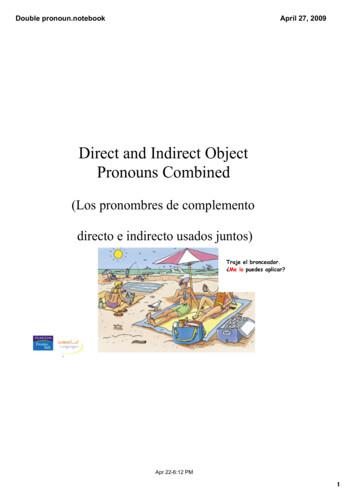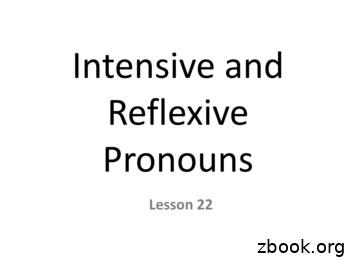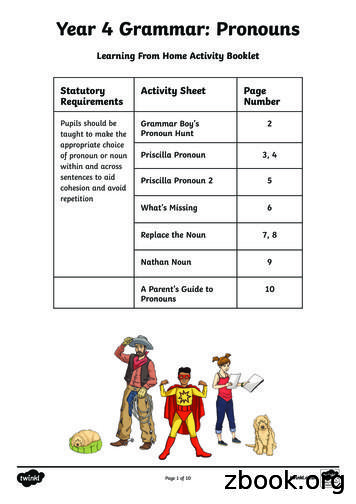Direct Object Pronouns, Indirect Object Pronouns,
Direct Object Pronouns, Indirect Object Pronouns, andDouble Object PronounsDirect Object Pronouns The object or person that directly receives the action of the verb is the direct object in the sentence. The direct object tells “what?” or “who?” is receiving the action of the verb. Direct object pronouns replace the direct object in a sentence.SpanishDirect Object PronounsEnglishSingular:metelolaPlural:nososloslas meyouhim, it (m.), you formal (m.)her, it (f.), you formal (f.) usyou-allthem (m.)them (f.) The direct objects me, te, and nos correspond to me, you, and us in English. No te creo.I don’t believe you. ¿Me amas?Do you love me? ¿Nos apoyas?Do you support us? The direct object generally follows the verb in English, but precedes (goes before) the verb in Spanish. Te veo.I see you. Lo compra.She buys it. La tienes.You have it. In the Spanish language, words can be masculine or feminine, singular or plural. Therefore all nounsand adjectives must agree in gender (masculine or feminine) and number (plurality or singularity).Direct object pronouns must also agree in gender and number with the noun they are replacing in thesentence (lo/la los/las).o The direct object lo corresponds to a masculine singular direct object of a sentence. Lo canmean it (m.), him or you formal (m.) in English. Miguel quiere el libro.Miguel wants the book.Miguel lo quiere.Miguel wants it. El libro is the direct object of the sentence. It answers the question “What?” “What doesMiguel want?” The book is a masculine singular noun and therefore is replaced by themasculine singular direct object pronoun lo.BCCC Tutoring Center Rev. 7/2015Spanish
Isabel ama a Oscar.Isabel loves Oscar.Isabel lo ama.Isabel loves him. Oscar is the direct object of the sentence. He answers the question “Who?” “Who doesIsabel love?” Oscar is a masculine singular noun (he is a boy, and there is only one ofhim), and therefore, is replaced by the masculine singular direct object pronoun la. Profesor Martinez: ¿Me puede oír?Professor Martinez: Can you hear me?Estudiante: No, no lo oigo bien.Student: No I can’t hear you well. Professor Martinez is speaking to a student. When the student responds, ProfessorMartinez is the direct object of the sentence. This is a formal situation, and therefore,the student responds with the you formal (m.) form of the direct object lo.o The direct object la corresponds to a feminine singular direct object of a sentence. La can meanit (f.), her or you formal (f.) in English. Margarita come la tortilla.Margarita eats the tortilla.Margarita la come.Margarita eats it. La tortilla is the direct object of the sentence. It answers the question “What?”“What does Margarita eat?” The tortilla is a feminine singular noun, andtherefore, is replaced by the feminine singular direct object pronoun la. Miguel ve a Luisa.Miguel sees Luisa.Miguel la ve.Miguel sees her. Luisa is the direct object of the sentence. She answers the question “Who?”“Who does Miguel see?” Luisa is a feminine singular noun (she is a girl, and thereis only one of her), and therefore, is replaced by the feminine singular directobject pronoun la. Doctora Ortega: ¿Me puede ver?Doctor Ortega: Can you see me?Paciente: Sí, la veo.Patient: Yes, I see you. Doctora Ortega is speaking to a patient. When the patient responds, DoctoraOrtega is the direct object of the sentence. This is a formal situation, andtherefore, the patient responds with the you formal (f.) form of the direct objectla.o The direct object los corresponds to a masculine plural direct object of a sentence. Maria tiene los bolígrafos.Maria has the pens.Maria los tiene.Maria has them. Los bolígrafos is the direct object of the sentence. It answers the question“What?” “What does Maria have?” The pens are masculine plural, andtherefore, are replaced by the masculine plural direct object pronoun los.BCCC Tutoring Center Rev. 7/2015Spanish
o The direct object las corresponds to a feminine plural direct object of a sentence. José lee las revistas.José reads the magazines.José las lee.José reads them. Las revistas is the direct object of the sentence. It answers the question “What?”“What does José read?” The magazines are feminine plural, and therefore, arereplaced by the feminine plural direct object pronoun las. When two verbs are used in combination (a conjugated verb followed by an infinitive), the directobject pronoun can be attached to the infinitive or placed before the conjugated (auxiliary) verb. Quiero comprarla mañana.I want to buy it tomorrow.La quiero comprar mañana.I want to buy it tomorrow. When an auxiliary verb is not used (no conjugated verb, only an infinitive), the direct object isconnected to the infinitive form of the verb. Antes de hacerlo, llama a tu madre.Before doing it, call your mother. When used with commands, the direct object is attached to the affirmative command and precedes(goes before) the negative command. Tómalo.Take it. Cómelas.Eat them.No lo tomes.Don’t take it.No las comes.Don’t eat them.BCCC Tutoring Center Rev. 7/2015Spanish
Indirect Object Pronouns The indirect object answers the question “To whom?” or “From whom?” is the action of the verbperformed.SpanishSingular:meteleIndirect Object PronounsEnglishPlural:nososles (to) me(to) you(to) him, (to) her, (to) it,(to) you formal (to) us(to) you-all(to) them, (to) you-all The indirect object pronoun, like the direct object pronoun, generally precedes (goes before) theconjugated verb. Miguel da el libro al muchacho.Miguel gives the book to the boy.Le da el libro.He gives him the book. Dije la verdad a mi madre.I told my mom the truth.Le dije la verdad.I told her the truth. When two verbs are used in combination (a conjugated verb followed by an infinitive), the indirectobject pronoun can be attached to the infinitive or placed before the conjugated (auxiliary) verb. Quiero hablarte ahora.I want speak to you now.Te quiero hablar ahora.I want to speak to you now. When an auxiliary verb is not used (no conjugated verb, only an infinitive), the indirect object isconnected to the infinitive form of the verb. Antes de hablarle, piensa bien en lo que vas a decir.Before speaking to him, think hard about what you are going to say. When a progressive tense is used (auxiliary verb present), the indirect object may go before the auxiliaryor be attached to the participle. Estaba hablándoles.I was speaking to them.Les estaba hablando.I was speaking to them. The indirect object must be attached to the present participle when it is not used with an auxiliary verb. No cambiarás nada hablándole así.You will not change anything speaking to him/her like that.BCCC Tutoring Center Rev. 7/2015Spanish
Double Object Pronouns Double object pronouns occur when both the indirect and direct object pronouns are used togetherwith the same verb. Both the indirect and direct object precede the verb. The indirect object comes before the directobject. Miguel me dio el libro.Miguel gave me the book.Me lo dio. Nos mandaron una carta.They sent us a letter.Nos la mandaron.He gave me it.They sent it to us. When both object pronouns are in the third person (le/les- lo/la/los/las), the indirect object (le or les)changes to se. La madre dio el juguete a su hijo.The mother gave the toy to her son.Se lo dio. Juan contó un chiste a Maria y Miguel.Juan told a joke to Maria and Miguel.Se lo dijo. Ellos mandaron cartas a sus amigas.They sent letters to their friends.She gave it to him.He told it to them.Ellos se las mandaron.They sent them to them. Double object pronouns (like single ones) are placed before a conjugated verb, or may be attached toan infinitive or present participle. Se la doy.I give it to her.Voy a dár sela.I am going to give it to her.Estoy dándo sela.I am giving it to her. They are always placed before negative commands and after affirmative commands. No me la de vuelvas inmediattamente.Do not return it to me immediately. Devuélvame la cuando quieras.Return it to me whenever you want.BCCC Tutoring Center Rev. 7/2015Spanish
Double Object Pronouns Double object pronouns occur when both the indirect and direct object pronouns are used together with the same verb. Both the indirect and direct object precede the verb. The indirect object comes before the direct object. Miguel me dio el
page 20 To choose pronouns appropriately. Pronouns in text page 24 To investigate the use of pronouns. Pronouns in writing page 28 To extend the use of pronouns in writing. oduction oster notes Pronouns (page 10) This poster presents the various words that can function as personal pronouns
but both pronouns must remain next to each other, that is, When using double pronouns, the Indirect Object ALWAYS comes first. both pronouns must come either in front of the conjugated verb Te la voy a traer más tarde. I am going to bring it to you later. or after the infinitive
In English Direct and indirect object pronouns go after the verb. If the verb is composed of a helping verb past participle, the object pronoun goes after the past participle. I haven't seen them. We have told you the truth. Mike had written it before leaving. In French Direct and indirect object pronouns usually go before the conjugated verb.
Personal Pronouns I, you, he, she Possessive Pronouns my, his, her, mine, ours, theirs Reflexive Pronouns myself, herself, himself Reciprocal Pronouns each other, one another Indefinite Pronouns anything, somebody, everyone, few, both, neither Relative Pronouns who, which, what, that, when, where Inter
Lesson 22 t Intensive and Reflexive Pronouns Reflexive Pronouns Reflexive pronouns are a bit different from the other kinds of pronouns. They cause the verb to reflect back on the subject . In other words, reflexive pronouns are used when the subject of the sentenc
The indirect object pronouns in Spanish are as follows: Singular Plural me (me) nos (us) te (you) os (you) le (him; her; you; it) les (them; you) In a sentence with an indirect object, there is always a direct object, either stated or implied. In the sentence "My grandmother writes me every week," me is the indirect object because my grandmother
page 2. Grammar Boy’s Pronoun Hunt. 1. I 2. he 3. his 4. ours 5. mine 6. yours 7. she 8. it 9. they Year 4 Grammar: Pronouns Answers page 3, 4. Priscilla Pronoun. Personal Pronouns Possessive Pronoun Relative Pronouns Reflexive Pronouns Demonstrative Pronouns I you he she it we they me him
Grade 2 must build on the strong foundation of Grades K-1 for students to read on grade level at the end of Grade 3 and beyond. Arkansas English Language Arts Standards Arkansas Department of Education























